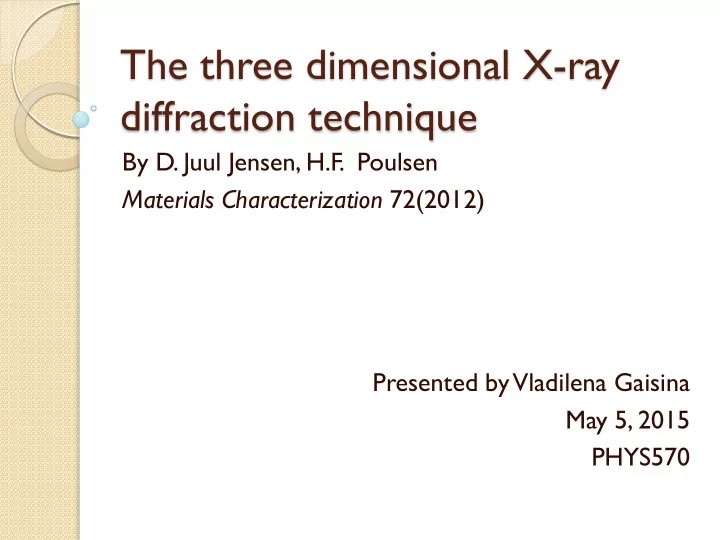

The three dimensional X-ray diffraction technique By D. Juul Jensen, H.F. Poulsen Materials Characterization 72(2012) Presented by Vladilena Gaisina May 5, 2015 PHYS570
Motivation T o study 3D microstructure or its evolution over time (4D) Existing methods have limitations ◦ 2D only (EBSP, TEM) ◦ Very small volumes (atom probe) ◦ Destructive (FIB) Requirements: non-destructive 3D, deep penetration in metals, good time resolution
Synchrotron 3DXRD Penetration depth at 50keV ◦ 5mm in steel ◦ 4cm in Al 1995 – preliminary data 1999 – ESRF builds 3DXRD microscope 3 dedicated microscopes: ◦ 2 permanent (ESRF, APS) ◦ 1 mobile (DCT)
Experimental setup DCT 3DXRD ~0.5 μ m ~2 μ m
Applications ◦ 1. ) Grain center mapping: fast measurements of average characteristics of each grain ◦ 2.) Complete 3D mapping: slower measurements with exact locations of grain boundaries and orientations
DCT Example
3DXRD Example 1: Plastic Deformation Grain Rotations Mode 1 Grain rotations for up to 10%-15% strains 4 different types of rotation behaviors Depends on initial orientation Used to validate crystal plasticity and texture models
3DXRD Example 2: Nucleation and Growth during Recrystallization Mode 2, taken before and after annealing Al cold rolled 30% and annealed 2 mins at 320 °C Six nuclei with new orientations, all close to one interior triple junction line Study of misorientation within parent grains and boundary motion
3DXRD Example 3: Crystal Structure of Pharmaceutical Compounds Traditionally used SCXRD or PXRD 2003: cupric acetate hydrate proof-of-concept Data from finite number of grains in powder sample ◦ Sort diffraction spots according to grain of origin ◦ Apply single-crystal software to each grain Comparable precision to SCXRD
Limitations and Future Trends 3DXRD techniques are constantly under development Limited spatial resolution Nano-scale: diffraction-based transmission X-ray microscopy (d-TXM) ◦ Subgrains, domains, twins ◦ Nanocrystalline materials ◦ 30nm in 5 years; 10nm ultimately?
Recommend
More recommend